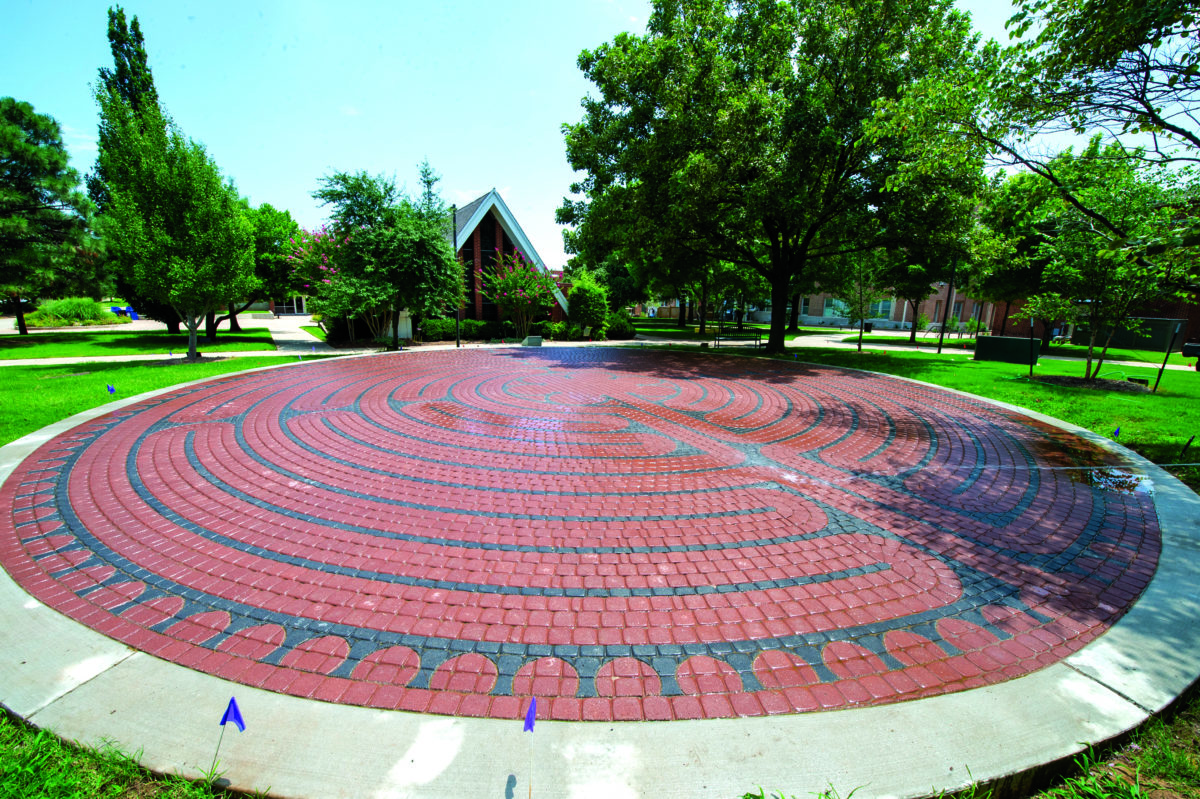Despite its mysterious origins, the labyrinth is one of the most distinct manmade designs, appearing in places all over the world for thousands of years. Although its winding pattern may resemble a maze, a true labyrinth has only one path that leads to and from its center.
The labyrinth’s unicursal pathway is commonly regarded as a metaphor for enlightenment and introspection, leading those who take it away from outside distractions before returning to the place they started.
Oklahoma is home to many labyrinths, several of which are located on college campuses. Students can benefit from the solace that labyrinths provide, encouraging mindfulness and reflection.
“The beauty of a labyrinth is that you take your whole self into it – mind, body and soul,” says Diane Rudebock, professor emerita of kinesiology and health studies at the University of Central Oklahoma. “[While] your body is moving, your mind is free to let thoughts come and go.”
Retracing the History of Labyrinths
Labyrinths have existed for more than 4,000 years. Although their exact place of origin is unknown, ancient cultures often carved their unique designs into coins, tombs, caves and jewelry. There are several types of labyrinths, which are classified by their number of circuits, or how many times the path encompasses the innermost point.
One of the most popular designs is the Classical Labyrinth (also known as the Cretan Labyrinth). This design includes seven circuits and originates from the Greek myth of Theseus and the Minotaur. According to legend, King Minos of Crete commissioned Daedalus to build a labyrinth that would imprison a ravenous Minotaur. Against all odds, Theseus braved the labyrinth and reemerged a hero, having slayed the beast.
The Greek myth inspired architecture during Medieval times, which gave way to another popular design: the Chartres labyrinth. Built around 1200 A.D., the first labyrinth of its kind was inlaid into the floor of the Chartres Cathedral in France. Its design is divided into four quadrants, consisting of 11 circuits.
Unlike the Greek myth, the Chartres Labyrinth was used as a contemplative tool, paralleling the journey to redemption. Many people continue to use labyrinths as a walking meditation.

Labyrinths at Oklahoma State University
OSU offers two different labyrinths on campus, the Morill Labyrinth and the Botanic Garden Labyrinth, which are free and open to the public. Both labyrinths were constructed in 2016.
Lou Anella, director of the OSU Botanic Garden, says that the university’s intention was to offer students a space to meditate and find peace.
The Morrill Labyrinth is located next to the Morill Hall and features three spiraling stone pathways that converge to a center point. The three sides of the labyrinth represent the connection between mind, body and spirit.
The Botanic Garden Labyrinth is a seven-circuit, Classical design, spanning half of a mile. The university created this labyrinth by planting Bermuda grass and using spray paint and stakes to map where to mow.
“We’ve really tried to put more things in the garden that entice people to come,” says Anella. “[The labyrinth] is a benefit to the community and is something that families enjoy with their children.”
The Southeastern Oklahoma State University Labyrinth
Located behind the Fine Arts Building, the SOSU labyrinth is a five-circuit Medieval labyrinth made of bricks and grass. The installation of the labyrinth was spearheaded by Charla Hall, professor emeritus of psychology at the university. As a trained labyrinth facilitator, Hall introduced several of her students to labyrinth walks, which helped build up momentum to construct one on campus.
At the time of the labyrinth’s construction, many students, faculty, and alumni showed up in support of the project. The labyrinth, which was slated as a two-day project, took only one day to finish due to the enthusiasm and cooperation of the community. Adding beauty to SOSU’s campus, the labyrinth provides a peaceful spot for students to reflect and relax in between classes.
Labyrinths at the University of Central Oklahoma
Labyrinths have become mainstays of UCO’s student life since the construction of its first one in 2013. Rudebock was instrumental in raising awareness about the transformative benefits of labyrinths. Introduced to walking meditations in 2000, Rudebock is also a certified labyrinth facilitator.
She began bringing a large canvas tarp with a labyrinth design as an activity for students to participate in during UCO’s summer leadership academy in 2003. Over 70 students tried the labyrinth during these retreats. The activity became so popular that the university began spray painting a design into the grass, where it eventually constructed its outdoor labyrinth.
From then on, students and faculty expressed interest in having a permanent, on-campus labyrinth. In 2013, UCO commissioned Marty and Debbie Keerman of Labyrinth in Stones to create the university’s outdoor design, which is a replica of the 11-circuit Chartres labyrinth in France.
“We were the first public university to have a labyrinth in Oklahoma,” says Rudebock. “To be able to have that available for our students, our staff, our faculty, the community – it really was a dream come true.”
In 2022, UCO installed a second labyrinth inside its gymnasium. Painted on the floor, this is a seven-circuit, Classical design. Faculty and students incorporate the indoor-and-outdoor labyrinths into their daily activities, using them as gathering places for musical performances and yoga classes. The university also observes Worldwide Labyrinth Day, which takes place every first Saturday in May.
Rudebock notes that there is no right or wrong way to explore a labyrinth, encouraging others to find one nearby.
“Bring your whole self … and prepare for an experience, whatever it may be,” she says. “When you experience a labyrinth, it meets you where you are.”
Main image cutline: At Oklahoma State University, the two constructed labyrinths offer students a space to meditate and find peace. Photo courtesy OSU























